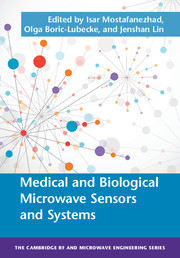Book contents
- Frontmatter
- Contents
- Contributors
- 1 Implantable Wireless Medical Devices for Gastroesophageal Applications
- 2 Embedded Wireless Device for Intracranial Pressure Monitoring
- 3 Wireless Intracranial Pressure Systems for the Assessment of Traumatic Brain Injury
- 4 Microwave Biosensors for Noninvasive Molecular and Cellular Investigations
- 5 Wearable Radar Tag Systems for Physiological Sensing/Monitoring
- 6 Physiological Radar Sensor Chip Development
- 7 Noise- and Interference-Reduction Methods for Microwave Doppler Radar Vital Signs Monitors
- 8 Biomedical Applications of UWB Technology
- Index
- References
2 - Embedded Wireless Device for Intracranial Pressure Monitoring
- Frontmatter
- Contents
- Contributors
- 1 Implantable Wireless Medical Devices for Gastroesophageal Applications
- 2 Embedded Wireless Device for Intracranial Pressure Monitoring
- 3 Wireless Intracranial Pressure Systems for the Assessment of Traumatic Brain Injury
- 4 Microwave Biosensors for Noninvasive Molecular and Cellular Investigations
- 5 Wearable Radar Tag Systems for Physiological Sensing/Monitoring
- 6 Physiological Radar Sensor Chip Development
- 7 Noise- and Interference-Reduction Methods for Microwave Doppler Radar Vital Signs Monitors
- 8 Biomedical Applications of UWB Technology
- Index
- References
Summary
Introduction
Intracranial pressure (ICP) monitoring is a significant tool that aids in the management of neurologic disorders such as hydrocephalus, head trauma, tumors, colloid cysts, and cerebral hematomas. ICP is the pressure exerted on the rigid, bony skull by its constituents, which are brain, cerebrospinal fluid (CSF), and cerebral blood. Increased ICP can lead to brain damage, disability, and death. Various modalities have been developed for monitoring ICP in hospitals and in ambulatory conditions. Currently, only catheter-based systems have made it to clinical practice. The catheter-based systems can only be used in a hospital setting and have a limited useful life owing to drift and the risk of infection. The wired methods of patient monitoring are cumbersome, cause patient discomfort, and can potentially introduce motion artifacts in the measured quantity. The contemporary medical world is witnessing a transition from a wired to a wireless healthcare domain.
Wireless Technology in Medical Use
The application of wireless technology in healthcare is becoming ubiquitous, if it is not already so. The therapeutic and diagnostic applications of radiofrequency (RF) and microwave technologies in medicine have been the subject of extensive study in the past [1–3]. Medical implants for the transfer of information at these nonionizing frequencies have been developed [4]. Research accomplishments using data communication links at microwave frequencies between a medical implant and an external unit have been reported by many researchers. The resonance characteristics of implanted antennas operating at a frequency band of 402 to 405 MHz and their radiation pattern outside the body have been shown to be favorable for short-range medical implants [5]. Poon et al. [6] demonstrated that the optimal frequency for power transmission in biologic media is in the gigahertz range. Gosalia et al. [7] demonstrated a novel approach of establishing a data telemetry link between an implant and an external unit in the 1.45 and 2.45 GHz band for retinal prostheses. Such medical implants are basic components for the success of telemedicine, which refers to the use of telecommunication technologies in healthcare. Telemedicine not only facilitates medical treatment and care but is also gaining popularity in posthospital patient care [8]. It provides expert consultation in remote understaffed locations and advanced emergency care via modern telecommunication techniques [9]. Mobile patient monitoring systems using wireless implants have been developed to maintain records of patient vital signs and history [10,11].
Information
- Type
- Chapter
- Information
- Medical and Biological Microwave Sensors and Systems , pp. 40 - 88Publisher: Cambridge University PressPrint publication year: 2017
